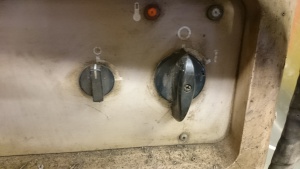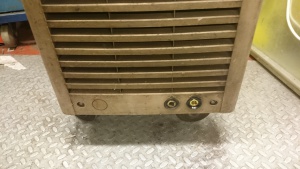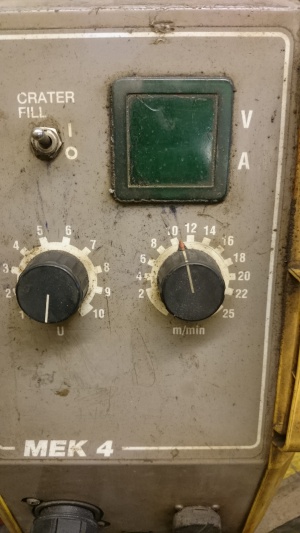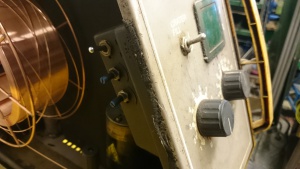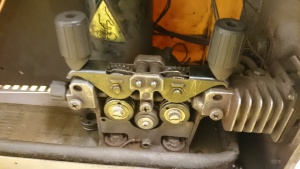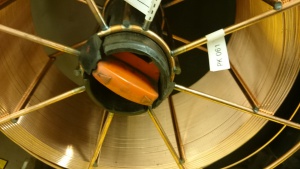ESAB MIG Welder: Difference between revisions
m Add risk assessment |
|||
| (16 intermediate revisions by 3 users not shown) | |||
| Line 1: | Line 1: | ||
MIG (Metal Inert Gas) welding (also known as GMAW - Gas Metal Arc Welding) uses wire fed through a welding 'gun' or 'torch'. The arc is struck between the wire and the workpiece, and shielded by an inert gas | {{Tool | ||
|image=File:ESAB MIG Welder.jpg | |||
|manufacturer=ESAB | |||
|model=LAW 500W | |||
|obtained= | |||
|obtaineddate= | |||
|location=Metalworking Area | |||
|team=Metalworking | |||
|induction=No | |||
|defunct= | |||
|defunctdate= | |||
|riskassessment=Team:Metalworking/Risk Assessments/Welding | |||
}} | |||
MIG (Metal Inert Gas) welding (also known as GMAW - Gas Metal Arc Welding) uses wire fed through a welding 'gun' or 'torch'. The arc is struck between the wire and the workpiece, and shielded by an inert gas flowing through the torch. For more information or an introduction to MIG welding, see the references at the bottom of this page. | |||
Our MIG welder is an ESAB LAW 500W | Our MIG welder is an ESAB LAW 500W with a separate wire feeder. The feeder is an ESAB MEK 4. The MIG torch is a 400 amp water cooled Binzel model. | ||
==Current Status== | ==Current Status== | ||
It | It's up and running, and it welds very nicely. The feed rollers and contact tip sometimes need replacing, contact the [[Team:metalworking|metalworking team]] if you think this needs doing. | ||
==Power Supply== | ==Power Supply== | ||
Currently shares a 32A 415V socket with the SMAW (stick) welder. A separate socket will be installed soon.<br/> | Currently shares a 32A 415V socket with the SMAW (stick) welder. A separate socket will be installed soon.<br/> | ||
[[File:Mig Welder Rating Plate.jpeg|thumb|400px|left|Rating Plate]] | |||
<br clear=all> | |||
==Quick Tour== | ==Quick Tour== | ||
| Line 14: | Line 29: | ||
| [[File:ESAB MIG Main Switches.JPG|frameless|left|Power and water pump switches]] || This is the power switch (the larger one on the right) and the switch for the water cooling pump (the smaller one on the left).'''Running the water cooling pump without a torch attached will damage the pump.''' The pump needs to be able to circulate through something. | | [[File:ESAB MIG Main Switches.JPG|frameless|left|Power and water pump switches]] || This is the power switch (the larger one on the right) and the switch for the water cooling pump (the smaller one on the left).'''Running the water cooling pump without a torch attached will damage the pump.''' The pump needs to be able to circulate through something. | ||
|- | |- | ||
| [[File:ESAB MIG welder earth sockets. | | [[File:ESAB MIG welder earth sockets.jpg|frameless|left|Work lead sockets]] || These are the two work lead sockets. The right hand one has higher inductance than the left. | ||
|- | |- | ||
| [[File:ESAB MIG Wire Feeder Controls.JPG|frameless|left|Front panel of wire feeder unit]] || This is the wire feed unit. At the back are connections for the welding current, water cooling, shielding gas and communications cable. On the front are connections for the mig torch (a euro style connector and two water cooling couplings) and for a remote control. There are two control knobs and a display. The left hand knob sets the welding voltage. The actual voltage used during the last weld will be displayed during the weld and after you finish. The right hand knob sets the wire feed speed. The switch is for 'crater fill' - this makes the machine taper off when you stop welding to try and avoid leaving a crater at the end of the weld. | | [[File:ESAB MIG Wire Feeder Controls.JPG|frameless|left|Front panel of wire feeder unit]] || This is the wire feed unit. At the back are connections for the welding current, water cooling, shielding gas and communications cable. On the front are connections for the mig torch (a euro style connector and two water cooling couplings) and for a remote control. There are two control knobs and a display. The left hand knob sets the welding voltage. The actual voltage used during the last weld will be displayed during the weld and after you finish. The right hand knob sets the wire feed speed. The switch is for 'crater fill' - this makes the machine taper off when you stop welding to try and avoid leaving a crater at the end of the weld. | ||
| Line 59: | Line 74: | ||
==Useful References== | ==Useful References== | ||
ESAB [http://www.esabna.com/euweb/mig_handbook/592mig1_1.htm MIG Handbook (esabna.com)] | |||
A more comprehensive guide from Lincoln Electric - [https://www.lincolnelectric.com/assets/global/products/consumable_miggmawwires-superarc-superarcl-56/c4200.pdf GMAW Guide (lincolnelectric.com)] | A brief introduction to MIG welding from Miller - [https://www.millerwelds.com/-/media/miller-electric/files/pdf/resources/bookspamphlets/mig_handbook.pdf Mig Handbook (pdf - millerwelds.com)] | ||
A more comprehensive guide from Lincoln Electric - [https://www.lincolnelectric.com/assets/global/products/consumable_miggmawwires-superarc-superarcl-56/c4200.pdf GMAW Guide (pdf - lincolnelectric.com)] | |||
Video introduction to MIG welding (weldingtipsandtricks) - [https://www.youtube.com/playlist?list=PLp0pALmMwc6v2ScmEGbvNSpNKcYA8GiGA Mig Welding Basics (youtube.com)] | Video introduction to MIG welding (weldingtipsandtricks) - [https://www.youtube.com/playlist?list=PLp0pALmMwc6v2ScmEGbvNSpNKcYA8GiGA Mig Welding Basics (youtube.com)] | ||
Guide to welding filler metals - [http://www.esabna.com/euweb/awtc/lesson1_1.htm Basic Welding Filler Metal Technology Correspondence Course ( | Guide to welding filler metals - [http://www.esabna.com/euweb/awtc/lesson1_1.htm Basic Welding Filler Metal Technology Correspondence Course (esabna.com)] | ||
==Tips== | |||
Torch is a BINZEL MB36, it takes MB36 M8 tips | |||
[[Category:Tools_and_Equipment]] | [[Category:Tools_and_Equipment]] | ||
[[Category:Metalwork]] | |||
Latest revision as of 22:02, 28 March 2025
| ESAB MIG Welder | |
|---|---|
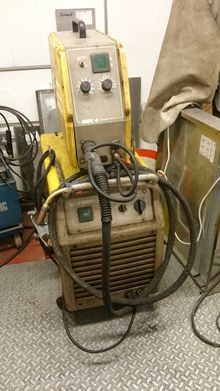 | |
| Manufacturer | ESAB |
| Model | LAW 500W |
| Location | Metalworking Area |
| Team | Metalworking |
| Induction Required | No |
| Risk Assessment | Yes, see the assessment |
| Tools: all pages • list • Power Tools • Broken tools {{}} | |
MIG (Metal Inert Gas) welding (also known as GMAW - Gas Metal Arc Welding) uses wire fed through a welding 'gun' or 'torch'. The arc is struck between the wire and the workpiece, and shielded by an inert gas flowing through the torch. For more information or an introduction to MIG welding, see the references at the bottom of this page.
Our MIG welder is an ESAB LAW 500W with a separate wire feeder. The feeder is an ESAB MEK 4. The MIG torch is a 400 amp water cooled Binzel model.
Current Status
It's up and running, and it welds very nicely. The feed rollers and contact tip sometimes need replacing, contact the metalworking team if you think this needs doing.
Power Supply
Currently shares a 32A 415V socket with the SMAW (stick) welder. A separate socket will be installed soon.
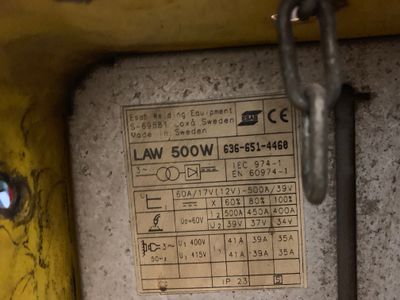
Quick Tour
Voltage Settings
This is a rough guide to settings - please correct or improve it if you discover something new.
| Dial Setting | Voltage Reported |
|---|---|
| 1 | 12.5V |
| 2 | 14.5V |
| 3 | 16.5V |
| 4 | 20.0V |
| 5 | 25.0V |
| 6 | 30.0V |
| 7 | 37.0V |
| 8 | 45.0V |
Manuals
LAW 500 Power Source (esab.com)
Useful References
ESAB MIG Handbook (esabna.com)
A brief introduction to MIG welding from Miller - Mig Handbook (pdf - millerwelds.com)
A more comprehensive guide from Lincoln Electric - GMAW Guide (pdf - lincolnelectric.com)
Video introduction to MIG welding (weldingtipsandtricks) - Mig Welding Basics (youtube.com)
Guide to welding filler metals - Basic Welding Filler Metal Technology Correspondence Course (esabna.com)
Tips
Torch is a BINZEL MB36, it takes MB36 M8 tips
